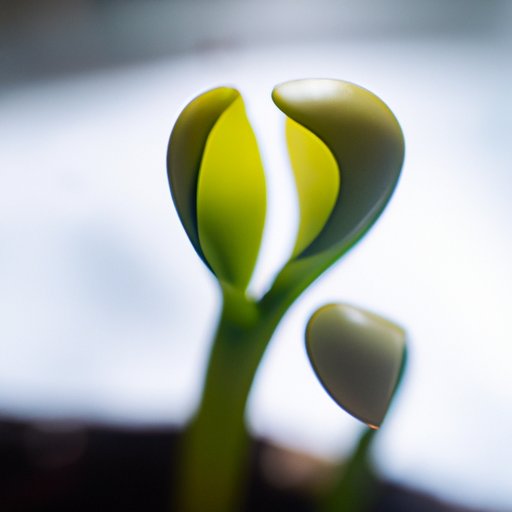Introduction
From towering trees to small garden herbs, all plants grow towards the sun. But why is sunlight so crucial for plant growth and development? In this article, we will explore the science behind sunlight and plants, and how sunlight affects various stages of a plant’s life cycle. We will also delve into the process of photosynthesis, the significance of sunlight in food production, and the environmental benefits of plants. Whether you are a seasoned gardener or simply interested in learning more about the natural world, this article will provide you with all the necessary information about why plants need sunlight.
The Science Behind Sunlight: Understanding How Plants Thrive
Sunlight is a form of electromagnetic radiation that travels in waves, and plants have evolved to use specific wavelengths of light for their growth and development. Chlorophyll, a pigment located in the chloroplasts of plant cells, is responsible for capturing light energy to produce food for the plant. The chlorophyll primarily absorbs red and blue wavelengths of light, while reflecting green light, which is why plants appear green to the human eye.
In addition to aiding in photosynthesis, sunlight also affects plant growth and development. Sunlight influences the shape, size, and texture of a plant’s leaves and stems, and can even affect the timing of flowering and fruiting.
Different wavelengths of light can affect various aspects of plant growth in different ways. For example, blue light is important for vegetative growth, while red light encourages flowering. Some plants may also respond to other wavelengths of light, such as far-red light, which can influence other physiological processes.
From Seed to Flower: The Importance of Sunlight in a Plant’s Life Cycle
Sunlight plays a vital role in all stages of a plant’s life cycle, from seed germination to flowering and reproduction. Seeds require a specific amount of light to germinate, and once the seedling has emerged from the soil, it needs sufficient sunlight to grow and establish a healthy root system.
The exposure to light also affects different parts of the plant. For instance, light intensity can influence the number and size of leaves, as well as the color and scent of flowers. Sunlight reaching the lower part of a plant can stimulate stem elongation, leading to a taller plant with longer internodes.
In terms of reproduction, light is essential in initiating the process of flower formation. While some plants require long periods of daylight to flower (known as long-day plants) and others require short periods (short-day plants), all plants require one essential ingredient – sunlight.
Unpacking Photosynthesis: Why Light is Crucial for Plant Growth
Photosynthesis is the process by which plants produce organic compounds, such as glucose, using light energy, carbon dioxide, and water. The process mainly takes place in the leaves, with the help of chloroplasts and other cellular components.
During the process of photosynthesis, the chlorophyll and other pigments absorb light energy, which is then used to convert carbon dioxide into organic compounds. The oxygen released during photosynthesis is vital for the survival of all animals, as well as for maintaining the balance of gases in the atmosphere.
In addition to producing oxygen, photosynthesis is also crucial for the plant’s survival and growth. The organic compounds produced during photosynthesis serve as the building blocks for the plant’s cells, tissues, and organs. Without photosynthesis, the plant would not be able to produce enough food to sustain itself, let alone provide for other organisms in the ecosystem.
Shedding Light on the Subject: How Sunlight Helps Plants Produce Food
While photosynthesis is essential for plant growth and development, the ability of the plant to use light for food production is influenced by different factors, such as the quality and duration of light, temperature, and the presence of other nutrients.
The availability of sunlight is crucial for the production of energy-rich molecules in plants, such as glucose, which is used for various metabolic processes within the plant. An adequate supply of sunlight can also impact the flavor, texture, and color of fruits and vegetables.
However, too little or too much sunlight can be detrimental to the plant’s health. Insufficient sunlight can lead to reduced growth and leaf yellowing, while excessive sunlight can cause leaf scorching and even death of the plant. This is why it’s important to carefully balance the amount of sunlight that your plants receive.
The Bright Side of Plants: How Sunlight Benefits Both Flora and Fauna
Plants are a critical component of the ecosystem, providing various environmental benefits. They absorb carbon dioxide and other air pollutants, release oxygen, and help regulate the temperature and humidity of the environment.
Plants also provide habitat and food for numerous animal species, from insects and birds to mammals and even humans. Healthy and thriving plant populations support diverse ecosystems, including forests, prairies, and wetlands.
By caring for your plants, you can help support the environmental benefits provided by plants and contribute to a healthier and more sustainable ecosystem.
Conclusion
In conclusion, the importance of sunlight in plant growth and development cannot be overstated. From seed germination to flowering and reproduction, light is a crucial component of a plant’s life cycle. By understanding the role of sunlight in photosynthesis and food production, you can provide the necessary conditions for your plants to thrive.
Caring for your plants not only benefits the plants themselves but also contributes to a healthier and more sustainable environment. So, whether you’re a gardener or just appreciate the beauty of nature, remember to give your plants the gift of sunlight.
